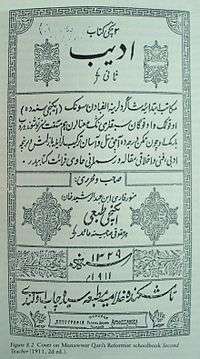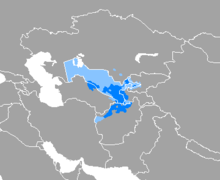Uzbek language
| Uzbek | |
|---|---|
| Oʻzbekcha | |
| Native to | Uzbekistan, Kyrgyzstan, Afghanistan, Kazakhstan, Turkey, Turkmenistan, Tajikistan, Russia, China |
| Ethnicity | Uzbek |
Native speakers | 27 million (2011–2014)[1] |
Early forms | |
|
Latin, Cyrillic, Arabic, Uzbek Braille (Uzbek alphabets) | |
| Official status | |
Official language in |
|
| Language codes | |
| ISO 639-1 |
uz |
| ISO 639-2 |
uzb |
| ISO 639-3 |
uzb – inclusive codeIndividual codes: uzn – Northern uzs – Southern |
| Glottolog |
uzbe1247[3] |
| Linguasphere |
44-AAB-da, db |
|
Dark blue = majority; light blue = minority | |
Uzbek is a Turkic language and the official language of Uzbekistan. It has 27 million native speakers and is spoken by the Uzbeks in Uzbekistan and elsewhere in Central Asia. Uzbek belongs to the Eastern Turkic, or Karluk, branch of the Turkic language family. External influences include Persian, Arabic and Russian. One of the most noticeable distinctions of Uzbek from other Turkic languages is the rounding of the vowel /a/ to /ɒ/ or /ɔ/, a feature that was influenced by Persian.
Name
In the language itself, Uzbek is oʻzbek tili or oʻzbekcha. In Cyrillic, the same names are written ўзбек тили and ўзбекча; in Arabic script, ازبېک تیلی and ازبېجه.
History
Turkic speakers probably settled the Amu Darya, Syr Darya and Zarafshan river basins since at least 600–700 CE, gradually ousting or assimilating the speakers of Eastern Iranian languages who previously inhabited Sogdia, Bactria and Khwarezm. The first Turkic dynasty in the region was that of the Kara-Khanid Khanate in the 9th–12th centuries,[4] who were a confederation of Karluks, Chigils, Yaghma and other tribes.[5]
Uzbek can be considered the direct descendant or a latter form of Chagatai, the language of great Turkic Central Asian literary development in the realm of Chagatai Khan, Timur (Tamerlane), and the Timurid dynasty[6] (including the early Mughal rulers of India). The language was championed by Ali-Shir Nava'i in the 15th and 16th centuries. Nava'i was the greatest representative of Chagatai language literature.[7][8] He significantly contributed to the development of the Chagatay language and its direct descendant Uzbek and is widely considered to be the founder of Uzbek literature.[9][10][11][12][13][14][15] Ultimately based on the Karluk variant of the Turkic languages, Chagatay contained large numbers of Persian and Arabic loanwords. By the 19th century it was rarely used for literary composition, but disappeared only in the early 20th century.
The term Uzbek as applied to language has meant different things at different times. Prior to 1921 "Uzbek" and "Sart" were considered to be different dialects:
- "Uzbek" was a vowel-harmonised Kipchak variety spoken by descendants of those who arrived in Transoxiana with Muhammad Shaybani in the 16th century, who lived mainly around Bukhara and Samarkand, although the Turkic spoken in Tashkent was also vowel-harmonised
- "Sart" was a Karluk dialect spoken by the older settled Turkic populations of the region in the Fergana Valley and the Qashqadaryo Region, and in some parts of what is now the Samarqand Region; it contained a heavier admixture of Persian and Arabic, and did not use vowel harmony
In Khiva, Sarts spoke a highly Persianised form of Oghuz Turkic. After 1921 the Soviet regime abolished the term Sart as derogatory, and decreed that henceforth the entire settled Turkic population of Turkestan would be known as Uzbeks, even though many had no Uzbek tribal heritage.
However, the standard written language that was chosen for the new republic in 1924, despite the protests of Uzbek Bolsheviks such as Fayzulla Khodzhayev, was not pre-revolutionary "Uzbek" but the "Sart" language of the Samarkand region. All three dialects continue to exist within modern spoken Uzbek. Edward A. Allworth argued that this "badly distorted the literary history of the region" and was used to give authors such as the 15th century author Ali-Shir Nava'i an Uzbek identity.[16]
Number of speakers
Estimates of the number of speakers of Uzbek vary widely. The Swedish encyclopedia Nationalencyklopedin estimates the number of native speakers to be 26 million,[17] and the CIA World Factbook estimates 25 million. Other sources estimate the number of speakers of Uzbek to be 21 million in Uzbekistan,[18] 3.4 million in Afghanistan,[19] 900,000 in Tajikistan,[20] 800,000 in Kyrgyzstan,[21] 500,000 in Kazakhstan,[22] 300,000 in Turkmenistan,[23] and 300,000 in Russia.[24]
Loan words
The influence of Islam, and by extension, Arabic, is evident in Uzbek loanwords. There is also a residual influence of Russian, from the time when Uzbeks were under the rule of the Russian Empire and the Soviet Union. Uzbek vocabulary has also been heavily influenced by Persian through its historic roots.
Dialects
The Uzbek language has many dialects, varying widely from region to region. However, there is a commonly understood dialect which is used in mass media and in most printed materials. Among the most-widespread dialects are the Tashkent dialect, Afghan dialect, the Ferghana dialect, the Khorezm dialect, the Chimkent-Turkestan dialect, and the Surkhandarya dialect.
Writing systems

Uzbek has been written in a variety of scripts throughout history:
- Pre-1928: the Arabic-based Yaña imlâ alphabet by literates, approximately 3.7% of Uzbeks at the time.[25]
- 1880s: Russian missionaries attempted to use Cyrillic for Uzbek.[25]
- 1928–1940: the Latin-based Yañalif used officially.
- 1940–1992: the Cyrillic script used officially.
- Since 1992: Yañalif is official in Uzbekistan, although the Cyrillic script is still widely used.
Despite the official status of the Latin script in Uzbekistan, the use of Cyrillic is still widespread, especially in advertisements and signs. In newspapers, scripts may be mixed, with headlines in Latin and articles in Cyrillic.[26] The Arabic script is no longer used in Uzbekistan except symbolically in limited texts[26] or for the academic studies of Chagatai (Old Uzbek).[25]
In the western Chinese region of Xinjiang, where there is a Uzbek minority, the Cyrillic is still used. However, the Uyghur Arabic alphabet is sometimes used.
Phonology
Vowels
| Front | ||
|---|---|---|
| Back | ||
| Close | i | u |
| Close-mid | e | o |
| Open | a | ɒ |
Consonants
| Labial | Dental | Alveolar | Palatal | Velar | Uvular | Glottal | ||
|---|---|---|---|---|---|---|---|---|
| Nasal | m | n | ŋ | |||||
| Plosive/Affricate | voiceless | p | t̪ | (ts) | tʃ | k | q | (ʔ) |
| voiced | b | d̪ | dʒ | a | ||||
| Fricative | voiceless | ɸ | s | ʃ | χ | h | ||
| voiced | β | z | (ʒ) | ʁ | ||||
| Approximant | l | j | ||||||
| Rhotic | r | |||||||
See also
References
- ↑ Uzbek at Ethnologue (18th ed., 2015)
Northern at Ethnologue (18th ed., 2015)
Southern at Ethnologue (18th ed., 2015) - ↑ Scott Newton (20 November 2014). Law and the Making of the Soviet World: The Red Demiurge. Routledge. pp. 232–. ISBN 978-1-317-92978-9.
- ↑ Hammarström, Harald; Forkel, Robert; Haspelmath, Martin; Bank, Sebastian, eds. (2016). "Uzbek". Glottolog 2.7. Jena: Max Planck Institute for the Science of Human History.
- ↑ "The Origins of the Uzbek Language" (in Russian). Retrieved 5 January 2013.
- ↑ Golden, Peter. B. (1990), "Chapter 13 – The Karakhanids and Early Islam", in Sinor, Denis, The Cambridge History of Early Inner Asia, Cambridge University Press, ISBN 0-521-24304-1
- ↑ Allworth, Edward (1994). Central Asia: 130 Years of Russian Dominance, a Historical Overview. Duke University Press. p. 72. ISBN 0-8223-1521-1.
- ↑ Robert McHenry, ed. (1993). "Navā'ī, (Mir) 'Alī Shīr". Encyclopædia Britannica. 8 (15th ed.). Chicago: Encyclopædia Britannica, Inc. p. 563.
- ↑ Subtelny, M. E. (1993). "Mīr 'Alī Shīr Nawā'ī". In C. E. Bosworth; E. Van Donzel; W. P. Heinrichs; Ch. Pellat. Encyclopaedia of Islam. VII. Leiden—New York: Brill Publishers. pp. 90–93.
- ↑ Valitova, A. A. (1974). "Alisher Navoi". In A. M. Prokhorov. Great Soviet Encyclopedia (in Russian). 17 (3rd ed.). Moscow: Soviet Encyclopedia. pp. 194–195.
- ↑ A. M. Prokhorov, ed. (1997). "Navoi, Nizamiddin Mir Alisher". Great Encyclopedic Dictionary (in Russian) (2nd ed.). Saint Petersburg: Great Russian Encyclopedia. p. 777.
- ↑ "Alisher Navoi". Writers History. Retrieved 26 January 2012.
- ↑ Maxim Isaev (7 July 2009). "Uzbekistan – The monuments of classical writers of oriental literature are removed in Samarqand". Ferghana News. Retrieved 26 January 2012.
- ↑ Kamola Akilova. "Alisher Navoi and his epoch in the context of Uzbekistan art culture development [sic]". San'at Magazine. Retrieved 28 January 2012.
- ↑ "Uzbek Culture". UzHotels. Retrieved 27 January 2012.
- ↑ "Alisher Navoi – The Crown of Literature". Kitob.uz Children's Digital Library (in Uzbek). Retrieved 8 February 2012.
- ↑ Allworth, Edward A. (1990). The Modern Uzbeks: From the Fourteenth Century to the Present: A Cultural History. Hoover Institution Press. pp. 229–230. ISBN 978-0-8179-8732-9.
- ↑ "Världens 100 största språk 2007" ("The World's 100 Largest Languages in 2007"), Nationalencyklopedin
- ↑ "Uzbekistan". CIA. Retrieved 7 December 2012.
- ↑ "Languages of Afghanistan". Ethnologue. Retrieved 7 December 2012.
- ↑ "Languages of Tajikistan". Ethnologue. Retrieved 7 December 2012.
- ↑ "Ethnic Makeup of the Population" (PDF). National Statistics Committee of the Kyrgyz Republic (in Russian). Retrieved 7 December 2012.
- ↑ "National Census 2009" (PDF). Statistics Agency of Kazakhstan (in Russian). Retrieved 7 December 2010.
- ↑ "Languages of Turkmenistan". Ethnologue. Retrieved 7 December 2012.
- ↑ "National Census 2010". Federal State Statistics Service (in Russian). Retrieved 7 December 2012.
- 1 2 3 Batalden, Stephen K. (1997). The Newly Independent States of Eurasia: Handbook of Former Soviet Republics. Greenwood Publishing Group. p. 194. ISBN 978-0-89774-940-4.
- 1 2 European Society for Central Asian Studies. International Conference (2005). Central Asia on Display. LIT Verlag Münster. p. 221. ISBN 978-3-8258-8309-6.
Sources
- Jahangir Mamatov, Michael Horlick, and Karamat Kadirova. A Comprehensive Uzbek-English Dictionary (eds.) Hyattsville, Maryland, 2 vol., 2011.
- Lars Johanson. "The History of Turkic." In Lars Johanson & Éva Ágnes Csató (eds) The Turkic Languages. London, New York: Rouiden & London, 1934, pp. 175–6.
- Yuri Bregel. "The Sarts in the Khanate of Khiva" Journal of Asian History Vol.12., 1978, pp. 146–9.
- András J. E. Bodrogligeti. Modern Literary Uzbek – A Manual for Intensive Elementary, Intermediate, and Advanced Courses. Munich, Lincom, 2 vols., 2002.
- William Fierman. Language planning and national development. The Uzbek experience. Berlin etc., de Gruyter, 1991.
- Khayrulla Ismatulla. Modern literary Uzbek. Bloomington, Indiana University Press, 1995.
- Karl A. Krippes. Uzbek–English dictionary. Kensington, Dunwoody, 1996.
- Republic of Uzbekistan, Ministry of Higher and Middle Eductation. Lotin yozuviga asoslangan oʻzbek alifbosi va imlosi (Latin writing based Uzbek alphabet and orthography), Tashkent Finance Institute: Tashkent, 2004.
- Andrée F. Sjoberg. Uzbek Structural Grammar. The Hague, 1963.
- A. Shermatov. "A New Stage in the Development of Uzbek Dialectology" in Essays on Uzbek History, Culture and Language. Ed. Bakhtiyar A. Nazarov & Denis Sinor. Bloomington, Indiana, 1993, pp. 101–9.
- Natalie Waterson (ed.) Uzbek–English dictionary. Oxford etc., Oxford University Press, 1980.
External links
| Uzbek edition of Wikipedia, the free encyclopedia |
| Wikibooks has more on the topic of: Uzbek language |
| Wikivoyage has a phrasebook for Uzbek. |
- Converters
- Uzbek Cyrillic–Latin converter
- Uzbek Cyrillic-Latin text and website converter
- Uzbek Latin-Cyrillic text and website converter
- Dictionaries
- Dictionary of the Uzbek Language Volume I (А—Р) (Tashkent, 1981)
- Dictionary of the Uzbek Language, Volume II (С—Ҳ) (Tashkent, 1981)
- English-Uzbek and Uzbek-English online dictionary
- English-Uzbek and Uzbek-English online dictionary
- Russian-Uzbek and Uzbek-Russian online dictionary
- Uzbek<>Turkish dictionary (Pamukkale University)
- Ole Olufsen: "A Vocabulary of the Dialect of Bokhara" (København 1905)
- Grammar and orthography
- Introduction to the Uzbek Language, Mark Dickens
- Principal Orthographic Rules For The Uzbek Language, translation of Uzbekistan Cabinet of Minister's Resolution No. 339, of August 24, 1995
- Uzbek alphabet, Omniglot
- Learning/teaching materials
- Ona tili uz, a website about Uzbek
- Uzbek language materials, Uz-Translations
